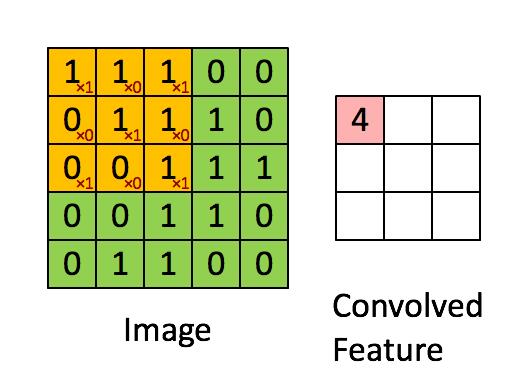UFLDL教程答案:Exercise:Convolution and Pooling
Posted slim1017
tags:
篇首语:本文由小常识网(cha138.com)小编为大家整理,主要介绍了UFLDL教程答案:Exercise:Convolution and Pooling相关的知识,希望对你有一定的参考价值。
教程地址:http://deeplearning.stanford.edu/wiki/index.php/UFLDL%E6%95%99%E7%A8%8B
练习地址:http://deeplearning.stanford.edu/wiki/index.php/Exercise:Convolution_and_Pooling
1.要点简述
卷积神经网络4个核心点:
局部连接,权重共享,池化,多层。
卷积神经网络结构可以看教程或者
http://blog.csdn.net/zouxy09/article/details/8781543
(1)局部连接与权值共享:
之前使用的mnist数据集28*28小图片使用全连接计算不会太慢,但如果是自然图片98*98,你需要设计近10 的 4 次方(100*100)个输入单元,假设你要学习 100 个特征,那么就有 10 的 6 次方个参数需要去学习。不管是前向传播还是反向传播都会很慢。
所以:每个隐含单元仅仅只能连接输入单元的一部分。例如,每个隐含单元仅仅连接输入图像的一小片相邻区域。这就是局部连接。
局部连接与权值共享不单单是为了减少计算量,这种方式是受人脑视觉神经系统启发设计的。设计原因有俩点:
1.自然图像中局部信息是高度相关的,形成局部motifs(这个词不知道该翻译成什么好,有点只可意会不可言传的感觉);
2.图像的局部统计特性对位置具有不变性,也就是说如果motifs出现在图像的某个地方,它也可以出现在任何其他地方。所以权值共享可以在图片的各个地方挖掘出相同的模式(一个feature map就挖掘一种模式)。

绿色为原图5*5,黄色为某个卷积核 3*3,红色3*3就是得到的一个feature map,为原图与此卷积核卷积的结果(也可以说原图被提取的特征)
注意有:feature map的3*3=(5-3+1)*(5-3+1),等式右边5为绿色长宽,3为黄色长宽
(2)池化:
虽然前面已经减少了很多参数,但是计算量还是很大,并且容易出现过拟合 (over-fitting),所以需要池化。
池化一般是最大值池化和平均值池化。
池化是平移不变性 (translation invariant)的关键。这就意味着即使图像经历了一个小的平移或者形变之后,依然会产生相同的 (池化的) 特征。
(3)网络结构:
输入层:为 64*64的图片,每张图RGB3个通道,64*64的大小,一共2000张训练样本。
卷积层:卷积核为 8*8,由前一个练习训练得到 W(400*192),b(400*1),其中192=8*8*3,代表8*8小图像块3通道的所有元素的权重,400表示400个不同的卷积核,即最终生成400个不同的feature map(每个大小为57*57,57=64-8+1)。
池化层:400个57*57的feature map被池化成400个3*3。
输出层:softmax层输入为400*3*3,输出4类(airplane, car, cat, dog)。
2.进入正题
Step 2a: Implement convolution
(1)Taking the preprocessing steps into account, the feature activations that you should compute is , whereT is the whitening matrix and
, whereT is the whitening matrix and  is the mean patch. Expanding this, you obtain
is the mean patch. Expanding this, you obtain , which suggests that you should convolve the images withWT rather thanW as earlier, and you should add
, which suggests that you should convolve the images withWT rather thanW as earlier, and you should add , rather than justb to convolvedFeatures, before finally applying the sigmoid function.
, rather than justb to convolvedFeatures, before finally applying the sigmoid function.
(2)im = squeeze(images(:, :, channel, imageNum));
这句可以看出squeeze函数就是去除维数为1的维度,如这句中channel,imageNum这两个维度维数都为1,被去除。
(3)conv2(im,feature,'valid');
conv2函数第3个参数shape=valid时,卷积时不考虑边界补零,即使输出矩阵维度为(imageDim - patchDim + 1, imageDim - patchDim + 1)
cnnConvolve.m
function convolvedFeatures = cnnConvolve(patchDim, numFeatures, images, W, b, ZCAWhite, meanPatch)
%cnnConvolve Returns the convolution of the features given by W and b with
%the given images
%
% Parameters:
% patchDim - patch (feature) dimension
% numFeatures - number of features
% images - large images to convolve with, matrix in the form
% images(r, c, channel, image number)
% W, b - W, b for features from the sparse autoencoder
% ZCAWhite, meanPatch - ZCAWhitening and meanPatch matrices used for
% preprocessing
%
% Returns:
% convolvedFeatures - matrix of convolved features in the form
% convolvedFeatures(featureNum, imageNum, imageRow, imageCol)
numImages = size(images, 4);
imageDim = size(images, 1);
imageChannels = size(images, 3);
convolvedFeatures = zeros(numFeatures, numImages, imageDim - patchDim + 1, imageDim - patchDim + 1);
% Instructions:
% Convolve every feature with every large image here to produce the
% numFeatures x numImages x (imageDim - patchDim + 1) x (imageDim - patchDim + 1)
% matrix convolvedFeatures, such that
% convolvedFeatures(featureNum, imageNum, imageRow, imageCol) is the
% value of the convolved featureNum feature for the imageNum image over
% the region (imageRow, imageCol) to (imageRow + patchDim - 1, imageCol + patchDim - 1)
%
% Expected running times:
% Convolving with 100 images should take less than 3 minutes
% Convolving with 5000 images should take around an hour
% (So to save time when testing, you should convolve with less images, as
% described earlier)
% -------------------- YOUR CODE HERE --------------------
% Precompute the matrices that will be used during the convolution. Recall
% that you need to take into account the whitening and mean subtraction
% steps
WT=W*ZCAWhite; %(400*192)*(192*192) 400是hiddenSize代表400种不同的feature map
B=b-WT*meanPatch;%(400*1) 这两步是根据教程step2a末尾的建议
% --------------------------------------------------------
convolvedFeatures = zeros(numFeatures, numImages, imageDim - patchDim + 1, imageDim - patchDim + 1);
for imageNum = 1:numImages
for featureNum = 1:numFeatures
% convolution of image with feature matrix for each channel
convolvedImage = zeros(imageDim - patchDim + 1, imageDim - patchDim + 1);
for channel = 1:3
% Obtain the feature (patchDim x patchDim) needed during the convolution
% ---- YOUR CODE HERE ----
%feature = zeros(8,8); % You should replace this
temp=patchDim*patchDim;
feature=reshape(WT(featureNum,1+(channel-1)*temp:channel*temp),patchDim,patchDim);
% ------------------------
% Flip the feature matrix because of the definition of convolution, as explained later
feature = flipud(fliplr(squeeze(feature)));
% Obtain the image
im = squeeze(images(:, :, channel, imageNum));%squeeze会消除只有1维的维度
% Convolve "feature" with "im", adding the result to convolvedImage
% 3通道都卷积后需要求和得到convolvedImage
% be sure to do a 'valid' convolution
% ---- YOUR CODE HERE ----
convolvedChannel=conv2(im,feature,'valid');%shape=valid时,卷积时不考虑边界补零
convolvedImage=convolvedImage+convolvedChannel;
% ------------------------
end
% Subtract the bias unit (correcting for the mean subtraction as well)
% Then, apply the sigmoid function to get the hidden activation
% ---- YOUR CODE HERE ----
convolvedImage=sigmoid(convolvedImage+B(featureNum)); %根据教程step2a末尾的建议
% ------------------------
% The convolved feature is the sum of the convolved values for all channels
convolvedFeatures(featureNum, imageNum, :, :) = convolvedImage;
end
end
end
function sigm = sigmoid(x)
sigm = 1 ./ (1 + exp(-x));
end
Step 2b: Check your convolution
运行自带的测试代码,显示:Congratulations! Your convolution code passed the test. 卷积代码无误!
Step 2c: Pooling
池化代码较为容易,使用卷积中类似for循环即可。
%采用和cnnConvolve.m中的循环顺序
pooledDim=floor(convolvedDim/poolDim);
for imageNum = 1:numImages
for featureNum = 1:numFeatures
for poolRow = 1:pooledDim
for poolCol = 1:pooledDim
poolMatrix = convolvedFeatures(featureNum, imageNum, (poolRow-1)*poolDim+1:poolRow*poolDim, (poolCol-1)*poolDim+1:poolCol*poolDim);
pooledFeatures(featureNum, imageNum, poolRow, poolCol) = mean(poolMatrix(:));
end
end
end
end
测试结果:Congratulations! Your pooling code passed the test.
结果:
(1)后面的代码NG已经给出,设置了stepSize = 50; 是为了避免内存溢出,分400/50=8次来计算,每次算50种feature map。如果电脑运行起来卡,把这个值改小些,改成10,20之类的。
(2)B = permute(A,order) 按照向量order指定的顺序重排A的各维。B中元素和A中元素完全相同。但由于经过重新排列,在A、B访问同一个元素使用的下标就不一样了。order中的元素必须各不相同。 --> A = randn(13,5,7,2); --> size(A) ans = 13 5 7 2 --> B = permute(A,[3,4,2,1]); --> size(B) ans = 7 2 5 13
即各维度调整了顺序,读数据时下标改变了。
(3)注意把需要的文件拷贝过来,程序跑完挺废时间的,所以保存好中间变量:
save('cnnPooledFeatures.mat', 'pooledFeaturesTrain', 'pooledFeaturesTest');
(4)结果:

以上是关于UFLDL教程答案:Exercise:Convolution and Pooling的主要内容,如果未能解决你的问题,请参考以下文章